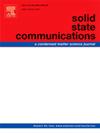Detection of air-decomposition products (CO, NOx) using Ag-doped MgCl2 monolayer
IF 2.4
4区 物理与天体物理
Q3 PHYSICS, CONDENSED MATTER
引用次数: 0
Abstract
To assess the operational reliability of air-insulated switchgear, the interaction of air decomposition products with sensing materials is investigated. This study focuses on the adsorption characteristics of Ag-doped MgCl2 (Ag-MgCl2) toward three common byproducts - CO and NOx (X = 1, 2) using Density Functional Theory (DFT). Various parameters such as adsorption energy, charge transfer, projected density of states (PDOS), and recovery time are analyzed for both pristine MgCl2 and Ag-MgCl2 monolayers. Results reveal that the pristine MgCl2 monolayer exhibits weak gas adsorption while the Ag-MgCl2 monolayer shows strong interactions with all three gases. The adsorption process on Ag-MgCl2 has reduces the band gap. Furthermore, the Ag-MgCl2 monolayer demonstrates a fast recovery time for NO2 which shows its potential for reusable gas sensing. Overall, the study provides theoretical insight into the feasibility of employing Ag-MgCl2 monolayers in sensors designed for air insulation systems.

利用掺银MgCl2单层检测空气分解产物(CO, NOx)
为了评估空气绝缘开关设备的运行可靠性,研究了空气分解产物与传感材料的相互作用。本文利用密度泛函理论(DFT)研究了ag掺杂MgCl2 (Ag-MgCl2)对三种常见副产物CO和NOx (X = 1,2)的吸附特性。分析了原始MgCl2和Ag-MgCl2单层膜的吸附能、电荷转移、投射态密度(PDOS)和恢复时间等参数。结果表明,原始MgCl2单层膜对气体的吸附较弱,而Ag-MgCl2单层膜对三种气体均有较强的相互作用。Ag-MgCl2的吸附过程减小了带隙。此外,Ag-MgCl2单层膜对NO2的回收时间短,显示了其可重复使用气体传感的潜力。总体而言,该研究为在空气绝缘系统传感器中使用Ag-MgCl2单层材料的可行性提供了理论见解。
本文章由计算机程序翻译,如有差异,请以英文原文为准。
求助全文
约1分钟内获得全文
求助全文
来源期刊

Solid State Communications
物理-物理:凝聚态物理
CiteScore
3.40
自引率
4.80%
发文量
287
审稿时长
51 days
期刊介绍:
Solid State Communications is an international medium for the publication of short communications and original research articles on significant developments in condensed matter science, giving scientists immediate access to important, recently completed work. The journal publishes original experimental and theoretical research on the physical and chemical properties of solids and other condensed systems and also on their preparation. The submission of manuscripts reporting research on the basic physics of materials science and devices, as well as of state-of-the-art microstructures and nanostructures, is encouraged.
A coherent quantitative treatment emphasizing new physics is expected rather than a simple accumulation of experimental data. Consistent with these aims, the short communications should be kept concise and short, usually not longer than six printed pages. The number of figures and tables should also be kept to a minimum. Solid State Communications now also welcomes original research articles without length restrictions.
The Fast-Track section of Solid State Communications is the venue for very rapid publication of short communications on significant developments in condensed matter science. The goal is to offer the broad condensed matter community quick and immediate access to publish recently completed papers in research areas that are rapidly evolving and in which there are developments with great potential impact.
 求助内容:
求助内容: 应助结果提醒方式:
应助结果提醒方式:


